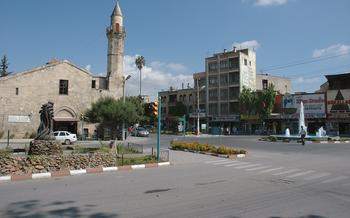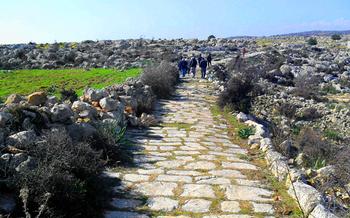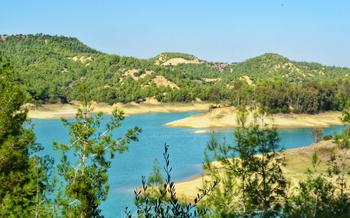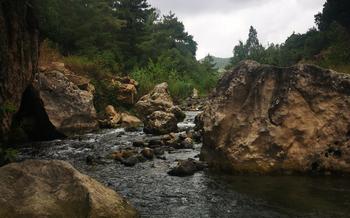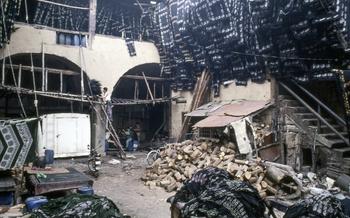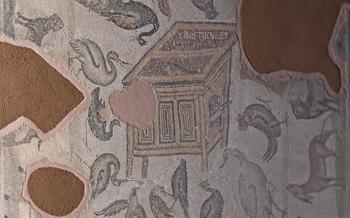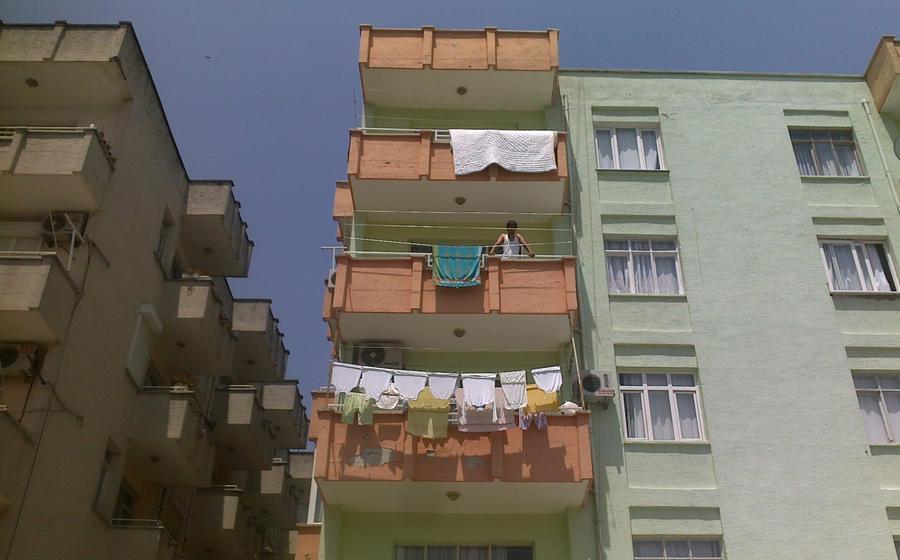
Saint Paul Church (Kadirli)
- History of the Saint Paul Church (Kadirli)
- Location and Accessibility
- Architectural Features
- Religious Significance
- Cultural and Historical Value
- Visiting the Church
- Exploring the Surroundings
- Photography and Videography
- Local Festivals and Events
- Contribution to Local Economy
- Local Legends and Folklore
- Church as a Symbol of Religious Tolerance
- Challenges and Threats to the Church
- Insider Tip: Unveiling Hidden Gems
History of the Saint Paul Church (Kadirli)
The Saint Paul Church, nestled in the heart of Kadirli, Osmaniye, Turkey, is an architectural masterpiece and a testament to the region's rich history. Its origins trace back to the early days of Christianity, when Saint Paul, one of the most prominent figures in the New Testament, visited the region on his missionary journeys. The church's construction was inspired by Saint Paul's presence and is believed to have been built in the 4th century AD, coinciding with the spread of Christianity throughout the Roman Empire.
Over the centuries, the church has undergone various modifications and renovations, reflecting the changing architectural styles and influences of the region. Despite these changes, it has retained its original essence and continues to stand as a symbol of faith and devotion. The church's endurance through the ages speaks to its historical significance and enduring spiritual importance to the local community.
Location and Accessibility
The Saint Paul Church in Kadirli is conveniently situated in the heart of the city, making it easily accessible to visitors. Its exact geographic location is 37°18'15"N 35°55'20.3"E, and it is easily reachable by car or public transportation. From major cities like Adana or Mersin, the church is approximately a 2-hour drive away. For those relying on public transport, regular buses and minibuses connect Kadirli to neighboring towns and cities, with stops near the church. The church's central location and accessibility make it a popular destination for both domestic and international tourists. It is also wheelchair accessible, ensuring that visitors with disabilities can comfortably explore the church's interior and exterior.
Architectural Features
The Saint Paul Church in Kadirli, Turkey, stands as a testament to the architectural prowess of its builders. Its exterior facade exudes an aura of grandeur, with intricate stone carvings adorning the entrance and windows. The church's design blends elements of Gothic and Byzantine architecture, creating a unique and harmonious style.
Upon entering the church, visitors are greeted by a spacious and awe-inspiring interior. The layout features a central nave flanked by two side aisles, creating a sense of symmetry and order. The soaring columns that support the vaulted ceiling add to the church's majestic ambiance.
Notable architectural details include the intricately carved pulpit, the ornate stained glass windows depicting biblical scenes, and the impressive dome that crowns the central section of the church. These elements combine to create a visual feast for visitors, showcasing the craftsmanship and artistic vision of the church's builders.
In comparison to other churches in the region, the Saint Paul Church stands out for its architectural grandeur and unique blend of styles. Its size and elaborate ornamentation set it apart as a significant religious and cultural landmark in Osmaniye, Turkey.
Religious Significance
The Saint Paul Church in Kadirli holds immense religious significance, deeply intertwined with the life and teachings of Saint Paul, a prominent figure in Christianity. According to tradition, Saint Paul, also known as the Apostle to the Gentiles, visited Tarsus, the ancient city near Kadirli, during his missionary journeys. This visit is believed to have played a pivotal role in spreading Christianity throughout the region.
The church, dedicated to Saint Paul, serves as a testament to his legacy and the enduring presence of Christianity in the area. Religious ceremonies and rituals, including masses, prayers, and special services, are regularly held within the church, attracting a congregation of devoted believers. Furthermore, the church's interior is adorned with religious iconography, including intricate mosaics, stained glass windows, and statues depicting biblical scenes and figures, which further enhance its spiritual atmosphere.
The Saint Paul Church remains a cherished symbol of faith and devotion for the local Christian community, providing a sacred space for worship, reflection, and spiritual connection. Its religious significance extends beyond the boundaries of the church, contributing to the region's rich cultural and historical tapestry.
Cultural and Historical Value
The Saint Paul Church stands as a testament to the rich history and cultural heritage of the region. It embodies the fusion of Christianity with local customs and traditions, creating a unique blend of religious and cultural significance. The church's architecture, rituals, and iconography reflect the deep-rooted beliefs and practices of the local community.
Throughout the centuries, the church has played a pivotal role in preserving and transmitting cultural traditions. Local artisans and craftsmen contributed their skills to its construction and decoration, incorporating traditional motifs and techniques into the church's design. Religious ceremonies and rituals held within the church often incorporate elements of local folklore and customs, further enriching its cultural significance.
Preservation efforts are ongoing to ensure that the church's cultural and historical value is maintained for future generations. Local authorities, in collaboration with heritage organizations, have undertaken restoration projects aimed at preserving the church's original features while respecting its historical integrity. These efforts not only safeguard the church's physical structure but also contribute to the preservation of the region's intangible cultural heritage.
One notable anecdote highlights the church's cultural significance. During a restoration project, a hidden chamber was discovered beneath the church. Within this chamber were ancient artifacts, including religious texts and manuscripts, that shed light on the church's early history and the practices of the early Christian community in the region. This discovery provided valuable insights into the cultural and historical context of the church, further solidifying its importance as a cultural heritage site.
The Saint Paul Church stands as a living testament to the enduring spirit of the local community and their commitment to preserving their cultural heritage. Visitors to the church are not only immersed in its religious significance but also gain a glimpse into the region's rich cultural tapestry.
Visiting the Church
When visiting the Saint Paul Church, appropriate attire and behavior are expected to show respect for the religious significance of the site. Visitors should dress modestly and avoid wearing revealing or inappropriate clothing. While exploring the church, it is important to maintain a respectful demeanor, speaking quietly and refraining from disruptive activities. Photography and videography are permitted inside the church; however, visitors should be mindful of the privacy and religious practices of other visitors. Using a flash or disturbing religious ceremonies is strongly discouraged.
The best time to visit the Saint Paul Church is during the off-season, typically between October and April, when the weather is pleasant, and there are fewer crowds. Guided tours are available upon request, providing visitors with a deeper understanding of the church's history and significance. Alternatively, self-guided exploration allows visitors to explore the church at their own pace, admiring its architectural details and soaking in the spiritual atmosphere.
Exploring the Surroundings
After immersing yourself in the spiritual and architectural wonders of the Saint Paul Church, take the opportunity to explore the captivating surroundings that offer a rich tapestry of historical, natural, and culinary delights. A short walk from the church, you'll find the ancient city of Kadirli, where you can wander amidst the ruins and remnants of a bygone era. Discover the fascinating stories behind the old mosques, caravanserais, and bathhouses that line the cobblestone streets, transporting you back in time.
For nature enthusiasts, the Taurus Mountains, with their majestic peaks and lush forests, beckon you to explore their breathtaking trails. Embark on a scenic hike, marveling at the diverse flora and fauna that inhabit this natural paradise. If you're feeling adventurous, consider a thrilling white-water rafting excursion on the Ceyhan River, offering an adrenaline-pumping experience amidst stunning landscapes.
No exploration of this region would be complete without savoring the delectable local cuisine. Indulge in the flavors of traditional Turkish dishes, such as freshly baked gözleme, succulent kebabs, and aromatic meze platters. Visit the local markets to sample an array of fresh produce, spices, and handmade delicacies, allowing you to immerse yourself in the vibrant culinary culture of the region.
To extend your stay and fully experience the charm of the area, consider exploring the nearby towns and villages. Discover hidden gems like the picturesque town of Silifke, with its ancient castle and pristine beaches, or venture further afield to the bustling city of Adana, renowned for its rich history and culinary delights. The possibilities for exploration are endless, offering an unforgettable journey that blends the spiritual, historical, natural, and gastronomic wonders of this captivating region.
Photography and Videography
Visitors are encouraged to capture the beauty and significance of the Saint Paul Church through photography and videography. However, it is essential to respect the religious nature of the site and the privacy of other visitors. Flash photography and loud noises should be avoided, and visitors should refrain from taking photos or videos during religious ceremonies or rituals.
When photographing the church's exterior, try to capture the grandeur of the facade, the intricate details of the stonework, and the surrounding landscape. Inside the church, focus on the impressive dome, the colorful stained glass windows, and the intricate carvings and artwork.
For videography enthusiasts, capturing the church's serene atmosphere and the spiritual energy within is recommended. Consider filming the flickering candles, the gentle chanting of prayers, or the solemn procession of worshippers.
By using photography and videography, visitors can not only document their visit but also share the beauty and significance of the Saint Paul Church with others, promoting its cultural and historical heritage.
Local Festivals and Events
The Saint Paul Church in Kadirli, Osmaniye, Turkey, is not only a sacred site but also a vibrant hub for religious and cultural celebrations throughout the year. Visitors planning their trip around specific festivals or events can immerse themselves in the rich traditions and festive spirit of the local community.
One of the most significant events associated with the church is the annual Saint Paul Festival, held in June or July. This colorful festival honors the life and teachings of Saint Paul, attracting pilgrims and visitors from across the region. The festival features religious processions, special ceremonies, music, dance performances, and traditional food stalls.
Other notable events include Easter celebrations, Christmas services, and various cultural festivals showcasing local crafts, music, and dance. These events offer a unique opportunity to witness the vibrant cultural heritage of the region and interact with the friendly and welcoming local community.
For an unforgettable experience, visitors are encouraged to plan their trip to coincide with one of these festivals. The church becomes a focal point of community life, allowing visitors to connect with the locals, learn about their customs, and embrace the spirit of celebration.
Contribution to Local Economy
The Saint Paul Church (Kadirli) plays a pivotal role in stimulating the local economy and generating tourism revenue. Its historical and religious significance attracts a steady stream of visitors, contributing to the economic growth of the region. The church's presence has led to the development of various tourism-related businesses, such as hotels, restaurants, souvenir shops, and transportation services. These businesses provide employment opportunities and income generation for local residents, fostering economic stability and prosperity within the community.
Moreover, the church's status as a cultural and religious landmark has positioned it as a key player in promoting local heritage and traditions. This has spurred collaborative initiatives between the church and tour operators, hotels, and hospitality services to create comprehensive tourist experiences. Visitors can immerse themselves in the region's rich history and culture through guided tours, special events, and exhibitions, while local artisans and traditional crafts are showcased and supported. The church's role in preserving and celebrating local heritage not only enriches the visitor experience but also contributes to the preservation of traditional skills and practices, further strengthening the local economy.
Local Legends and Folklore
Over the centuries, the Saint Paul Church in Kadirli has become intertwined with local legends and folklore, adding a mystical dimension to its history. One popular tale speaks of a hidden treasure believed to be buried beneath the church. According to legend, the treasure was left by Saint Paul himself as a blessing to the community, and it is said to hold immense power and wealth. Many have searched for the treasure over the years, but none have been successful, further fueling the allure and mystique of the church.
Another legend tells of a miraculous spring that once flowed near the church. It is said that the spring possessed healing properties and that those who drank from its waters were cured of various ailments. The spring is no longer visible, but the legend lives on, symbolizing the spiritual and healing significance of the church to the local community.
These legends and stories have been passed down through generations, shaping the cultural identity of the region and adding to the charm and allure of the Saint Paul Church. They serve as a reminder of the deep connection between the church and the people of Kadirli, a connection that has stood the test of time and continues to inspire and fascinate visitors to this day.
Church as a Symbol of Religious Tolerance
The Saint Paul Church in Kadirli stands as a testament to the rich history of religious tolerance and coexistence in the region. Throughout the centuries, the church has been a place of worship for Christians, a center for interfaith dialogue, and a symbol of mutual respect among different faiths. The local community has long embraced religious diversity, fostering an environment where people of all beliefs can practice their faith freely.
The church's architecture and symbolism reflect this spirit of tolerance. Its design incorporates elements from both Christian and Islamic traditions, showcasing the harmonious blending of cultures. Inside the church, visitors can find iconography and artwork depicting scenes from the Bible and the Quran, side by side, highlighting the commonalities and shared values between the two religions.
The church's ongoing role in promoting interfaith dialogue is evident in the various events and initiatives it hosts. Regular gatherings, workshops, and seminars bring together people of different faiths to discuss shared values, explore common ground, and build bridges of understanding. These events foster a sense of community and cooperation, breaking down barriers and prejudices.
Visitors to the Saint Paul Church can witness firsthand the power of religious tolerance and the positive impact it has on the local community. The church serves as a reminder that despite differences in beliefs, people can live together in peace and harmony, celebrating their unique traditions while respecting those of others.
Challenges and Threats to the Church
The enduring legacy of the Saint Paul Church is not without its challenges. Environmental factors, such as earthquakes, harsh weather conditions, and air pollution, pose significant threats to the preservation of the church's delicate architecture and historical integrity.
Human-induced factors also contribute to the challenges faced by the church. Vandalism, neglect, and unauthorized development in the vicinity can damage the structure and disrupt the serene atmosphere of the site.
Balancing the need for tourism and the preservation of the church's heritage is a delicate task. While tourism can generate revenue for conservation efforts, it can also lead to increased foot traffic, wear and tear, and potential damage to the site.
To mitigate these threats and ensure the long-term sustainability of the church, a comprehensive strategy is necessary. This may involve implementing strict conservation regulations, raising awareness about the importance of preserving the site, and fostering collaboration between local authorities, heritage organizations, and the community to safeguard this invaluable cultural and religious treasure.
Insider Tip: Unveiling Hidden Gems
Beyond its historical significance, the Saint Paul Church holds hidden treasures that often go unnoticed by visitors. Explore the side chapels and discover intricate frescoes depicting biblical scenes. These artworks, often overlooked, offer a glimpse into the church's rich artistic heritage.
For a truly unique experience, visit during the annual Saint Paul Festival. This vibrant celebration features traditional music, dance, and food, providing an immersive cultural experience. Engage with locals, participate in festivities, and gain a deeper understanding of the church's role in the community.
Photography enthusiasts should capture the church's ethereal beauty during the golden hour. As the sun casts a warm glow on the stone facade, the church exudes a magical aura. Experiment with different angles and perspectives to create stunning images.
